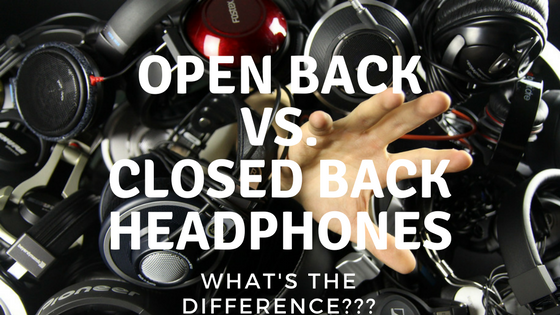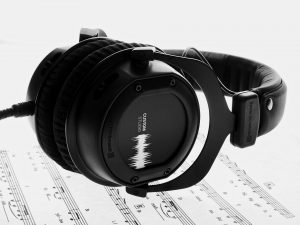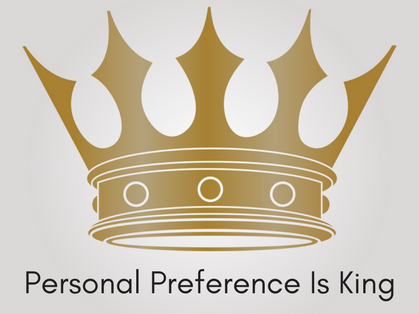
Open Back vs Closed Back Headphones – What’s The Difference?
If you’re wondering about what the difference between open back vs closed back headphones is, you’ve come to the right place. There are some differences between each of their respective build designs and the type of sound quality also plays a major role.
You’ll hear varying opinions on which model type is the best and why. For this article, we’ll take a closer look at the main features that set them apart from one another.
Open Back vs Closed Back Headphones

One major difference between these two types of headphones is that open backs feature an ear cup that looks similar to a fan. It has an open-air design that will give you more “headspace”. This also allows you to experience a more “true-to-life” sonic experience.
For a more-spacious soundscape, many audiophiles prefer the open-air style. A lot of people, maybe including yourself, agree that live music almost always sounds the best. When you can feel the music pulsing through your entire body, it’s a powerful feeling.
Open Back – What’s The Big Idea?

The idea behind the open style is that you’re attempting to get your audio to sound as close to the live experience as possible (without actually going to a show).
If you’re someone who usually enjoys your music in a private setting (like your bedroom for example) it’d be well worth your time to give the open style a listen. Keep in mind that since they allow sound to leak out, they also let ambient noise through into your ears.
They’re pretty much the opposite of models that utilize noise-cancelling features to block ambient noise out completely. Imagine you’re sitting in a room by yourself with your studio monitors or speaker setup turned all the way up. There aren’t any neighbors to disturb and you just want to let your music breathe.
That’s the type of sound that open-air headphones do their best to emulate.
Increased Ventilation

Another positive benefit of this type is the additional airflow. Since your ears will be allowed to breathe, it can make your listening session that much more enjoyable. As you know, sweaty build-up is never fun. For those of us that love marathon-listening, a comfortable headband, memory foam earpads, and the extra airflow can go a long way.
Lightweight Build Design
Since there are fewer materials involved in building an open-air set of cans, that means that there will be less weight to pull down on your skull. This is also a pretty great benefit for marathon-listening sessions.
It’s not uncommon to find a pair that weighs as much as, or even less than some of the earbud models used for working out.
Planar Magnetic Drivers
Many ‘phones of this design feature planar magnetic drivers. They utilize magnetic fields (similar to dynamic drivers) to produce an overall more accurate audio representation. This is done through the even vibration of a diaphragm instead of a voice coil.
Since they operate on the planar magnetic system, they tend to be bulkier and therefore less portable. This is another reason why most listeners prefer to use this style for at-home listening.
Price Difference (On Average)
One possible downside to this style of cans is the generally higher price tag. Although you can find a decent model for under $200 from Audio-Technica or Sennheiser, the more high-end models can go for upwards of $1000.
As you know, they make different headphones for different purposes but if you want to see a good example of the open-air design, Sennheiser’s RS 135 Open-Air or the RS 185 Wireless System are both great examples of solid ‘phones (especially useful for watching TV or movies).
Closed Back – Benefits and Examples

Some of us use headphones as a way to not only listen to our favorite songs but also to keep out the sound of a noisy crowd or barking dog at the same time. For noisy environments, it seems like a no-brainer to use the closed style.
The closed ear cup design holds most of the audio inside and doesn’t allow for much sound leakage to the outside. While this does tend to vary from headphone to headphone, a closed ear cup is better for keeping your music to yourself. (Especially in a setting where you don’t want to disturb other people – like on a bus, in the subway, on an airplane, or at your office, etc.)

There has been a small group of people that report having minor pressure issues with ANC features. Although they’re the minority, I would recommend trying a quality pair of the open ear cup design to minimize the pressure issues. (You could also use some earbuds or noise-isolating designs instead.)
For a More Traditional Personal Audio Experience
Closed back are the more traditional, more widely used, headphone design. With the exception of earbuds that are commonly included with smartphone purchases, your favorite pair of ‘phones most likely belong to this category.
Most Beats, Sony, Audio-Technica, etc. are designed for maximum comfort and sound fidelity. That, plus the noise-cancelling features (active/adaptive) make for a pretty isolated, personal listening experience.
Ventilation Factors
Although you can find some pretty breathable ‘phone models with the closed design, it’s hard to compete in this area with the open-air design. Multiple factors play a role in the level of ventilation but certain types of ear pads and coverings are better than others for this purpose.
Leatherette coverings can be less breathable than velour or genuine leather. They even make hybrid mixes of leatherette and genuine leather that some prefer over both. As far as the actual ear cup build, this style tends to allow more heat to build up and it’s always a good idea to take a breather once in a while and let your ears rest.
Heavier Build Design

Due to the extra materials used to enclose the inner-workings of your ear cups, these models tend to be a little bit heavier. The actual difference in the feel between the two can be night and day. Some pairs weigh more than twice as much as your average open-style models. A good example of an ultra-lightweight closed design is the Beyerdynamic DT 1350.
Dynamic Drivers
On average, ‘phones of this style usually feature dynamic drivers. The sound is produced through the vibration of voice coils (as opposed to a large-diaphragm). A common criticism of this type of driver is that they tend to distort your audio (more than planar magnetic drivers do). Dynamic drivers are also great for improving bass response and saving on manufacturing costs.
For the casual audio enthusiast, it really isn’t too much of an issue. If you consider yourself an audiophile, you probably value planar magnetic over dynamic drivers.
Price Difference – Usually Less Expensive
The closed ear cup models usually cost less than open ear cup models. This is partially due to the minimized manufacturing costs. For hifi enthusiasts, the sound quality outweighs the cost, so they’re willing to spend the extra cash for better sound fidelity.
As mentioned above, for the casual or even intermediate listener (with a more peripheral interest in hi-res audio reproduction) the closed-style set of cans will still be able to give you exactly what you’re looking for.
Overall – Personal Preference is King

When it comes to making your decision on which style will work for you, ultimately it comes down to which of the above criteria that you value the most.
If lightweight, breathable designs and spacious, ultra-hifi sound fidelity is your cup of tea, you’ll probably enjoy a nice pair of open headphones.
If you like comfortable, portable, less-expensive, versatile ‘phones that isolate your music to your ears, you’ll probably prefer the closed style.
Here’s a short 4-minute video going over the main differences one more time:
Now that you’ve read through til the end, I hope your questions about open-back vs. closed-back headphones were answered. If not, and you need further clarification, feel free to leave a question or comment below.
I’ll be sure to respond as soon as I can (usually less than 24 hours). Thanks for stopping by, feel free to take a look at some of the other content here as well!
Sonic Elevation: Ride The Waves.
- Korg B2 vs Roland FP10 | Which One To Buy - May 13, 2021
- How Does Music Affect The Brain? – Let’s Find Out! - April 6, 2021
- Why Are My Headphones Crackling? – How To Fix It - April 3, 2021
What are your thoughts on Grado Labs headphones?
I think Grado Labs is an underrated headphone company for several reasons. For one, their headphones are all hand made. They also have a pretty wide range of options and headphones that can adapt to anyone’s budget, whether you have $80 or $1700 to spend.
Their over-ear models have gotten a lot of positive feedback and they definitely specialize in open-back headphone design.
Thanks for your question! 🙂
I’ve never heard of open back headphones before, I’ve always gone for noise cancelling, particularly when I lived in the city. But I’m intrigued by the idea of listening to music that sounds as if you’re listening to it live. I don’t get to go to concerts all that often, so the idea of being able to get headphones that simulate the same sounds as if I were at a concert is very cool. I may have to try these, thanks for sharing!
Noise cancelling headphones are definitely a great choice if you live in a highly populated area.
I think you’ll be blown away by the difference in sound quality if you decide to try a pair of open-back headphones in the future!
They’re not recommended for use outside – but if you wear them in a quiet space, they’ll get you as close to the live concert sound as possible.
Thanks for stopping by, I’m glad you discovered a new style of headphones. 🙂